We will have limited operations from 15:00 Tuesday 24 December 2024 (AEDT) until Thursday 2 January 2025. Find out how to contact us during the holiday period.
Referred scheduling proposal
An application was submitted to include stenabolic (SR9009) and synthetic REV-ERB agonists in Schedule 9 in the Standard for the Uniform Scheduling of Medicines and Poisons (SUSMP) – the Poisons Standard.
Scheduling application
This was a general application. The applicant’s proposed amendments to the Poisons Standard are:
Schedule 9 – New Entry
The applicant's reasons for the request are:
- Apply for a grouped REV-ERB agonists schedule entry to cover all related compounds, including SR9011, GSK2945, GSK0999, GSK5072 and GSK2667. These substances should be considered as Schedule 9 poisons due to their potential to produce toxic side-effects and potential for misuse and abuse in sports doping.
- Stenabolic (SR9009) (and its related compounds) has not been widely tested for safety in humans. Much of the available research to date is in pre-clinical animal models. These studies suggest that SR9009 and other synthetic REV-ERB agonists can alter the circadian rhythm in rodents (and likely to do this in humans) which has implications for sleep, metabolic issues and potentially mental health problems.
- Scheduling of stenabolic aims to protect public health from the potential adverse impacts of these unapproved substances. The supply of stenabolic products poses health concerns as they are being administered without appropriate trials in humans, without guidelines for the appropriate dosages and frequency of dosages and without knowledge of the exact contents of the product being administered.
- SR9009 and is related compounds are currently sold online as 'workout in a pill' type drugs and other derivatives. It has the potential to enter the Australian market in this space.
- Despite the experimental status of these products they are readily available for purchase in Australia through online suppliers, based in Australia and overseas, and through compounding pharmacies and anti-ageing clinics.
- The lack of regulation allows suppliers to advertise products with stenabolic freely and make unproven assertions about the efficacy and safety of the substances. On bodybuilding forums and black-market sites, stenabolic is being positioned as a cutting-edge alternative to steroids.
- The substances are being used by athletes and gym users for the enhancement of sporting performance and aesthetics.
- Stenabolic may be a potential carcinogen and its effect on humans has not been systematically investigated.
- The Australian Sports Anti-Doping Authority (ASADA) has advised that stenabolic has been seized at the border by the Australian Border Force as prohibited imports on multiple occasions.
- Stenabolic is also prohibited under the World Anti-Doping Agency (WADA) Prohibited List category S4 'Hormone and Metabolic Modulators'.
Current scheduling status and relevant scheduling history
Stenabolic has not previously been considered for scheduling. Therefore, a scheduling history is not available.
Australian regulatory information
Stenabolic is not listed in the Therapeutic Goods (Permissible Ingredients) Determination No. 4 of 2017, and is not an excipient or active in any medicines on the ARTG.
International regulations
World Anti-Doping Agency (WADA)
Stenabolic is also prohibited under the World Anti-Doping Agency (WADA) Prohibited List category S4 Hormone and Metabolic Modulators.
According to a respected endocrinologist, Stenabolic is captured as a prohibited substance under WADA’s Prohibited List category S4 Hormone and Metabolic Modulators and its potent and diverse pharmacological effects warrant its listing on the Poisons Standard. Direct inquiries with WADA regarding prohibited status have been less definitive. WADA advised that this will be a specific item of consideration for the prohibited list expert group on 24-25 August 2017, where further advice will be provided. Regardless of this further consideration, and as other derivatives have the potential to enter the Australian market, it is requested that a class entry for synthetic REV-ERB agonists be considered for Schedule 9 with additional separate entries for SR9011, GSK2945, GSK0999, GSK5072 and GSK2667.
United States of America
Substance summary
| Chemical | CAS number | IUPAC and/or common and/or other names | Structure |
|---|---|---|---|
| Stenabolic | 1379686-30-2 |
ethyl 3-[[(4-chlorophenyl)methyl-[(5-nitrothiophen-2-yl)methyl]amino]methyl]pyrrolidine-1-carboxylate (IUPAC); 1S/C20H24ClN3O4S/c1-2-28-20(25)23-10-9-16(13-23)12-22(11-15-3-5-17(21)6-4-15)14-18-7-8-19(29-18)24(26)27/h3-8,16H,2,9-14H2,1H3 (InChI); SR9009 |
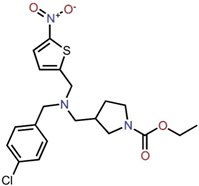 |
| SR9011 | 1379686-29-9 |
3-[[(4-chlorophenyl)methyl-[(5-nitrothiophen-2-yl)methyl]amino]methyl]-N-pentylpyrrolidine-1-carboxamide (IUPAC); 1S/C23H31ClN4O3S/c1-2-3-4-12-25-23(29)27-13-11-19(16-27)15-26(14-18-5-7-20(24)8-6-18)17-21-9-10-22(32-21)28(30)31/h5-10,19H,2-4,11-17H2,1H3,(H,25,29) (InChI); |
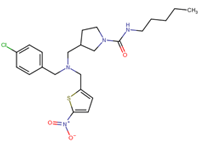 |
| GSK2945 | 1438071-12-5 |
N-[(4-chloro-2-methylphenyl)methyl]-1-(4-chlorophenyl)-N-[(5-nitrothiophen-2-yl)methyl]methanamine (IUPAC); 1S/C20H18Cl2N2O2S/c1-14-10-18(22)7-4-16(14)12-23(11-15-2-5-17(21)6-3-15)13-19-8-9-20(27-19)24(25)26/h2-10H,11-13H2,1H3 (InChI); |
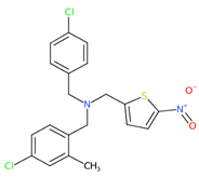 |
| GSK0999 | N/A | N/A | 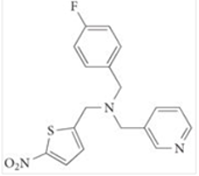 |
| GSK5072 | 1438071-23-8 |
5-[[(4-chlorophenyl)methyl-(pyridin-3-ylmethyl)amino]methyl]thiophene-2-carbonitrile (IUPAC); 1S/C19H16ClN3S/c20-17-5-3-15(4-6-17)12-23(13-16-2-1-9-22-11-16)14-19-8-7-18(10-21)24-19/h1-9,11H,12-14H2 (InChI); |
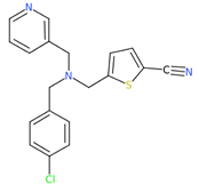 |
| GSK2667 | N/A | N/A | N/A |
Stenabolic (SR9009) was developed as an orally active REV-ERBα ligand acting on a heme regulated, nuclear receptor. A non‐exclusive list of its pharmacological actions of SR9009 and other synthetic REV-ERB agonists suggests they alter the circadian rhythm in rodents (and likely to do this in humans), which has implications for sleep, metabolic issues and potentially mental health problems[17]
Stenabolic and its related compounds have not been widely tested for safety in humans. Despite this lack of testing, it is being sold online with a wide range of unsupported health claims.
Stenabolic is an agonist of the orphan receptors REV-ERBα and REV-ERBβ[18] The alpha isoform is encoded by the complementary DNA/RNA strand of the ERBA oncogene, while the beta isoform is encoded by the template strand within the same chromosome. These receptors are constitutive repressors of transcription through their binding to co-repressors (e.g. nuclear receptor co-repressor 1).
REV-ERB co-repressor binding activity leads to repression of target chromosomal sequences via DNA response elements through histone deacetylation and chromatin condensation. Heme is an endogenous ligand required for REV-ERB recruitment of the co-repressor, with the redox state of the iron centre and diatomic gases such as nitric oxide influencing co-repressor binding and hence downstream activity.
REV-ERB receptors are widely expressed throughout the body and have a circadian pattern of expression that reflects their role in circadian transcription regulation. The expression of REV-ERBs and the transcription activator ‘retinoic acid receptor-related orphan receptor’ (ROR) are 12 hours out of phase with one another, with their influence on transcription of the core mammalian circadian proteins ‘brain and muscle ARNT-like 1’ (BMAL1) and ‘circadian locomotor output cycles protein kaput’ (CLOCK) reinforcing core circadian oscillation. REV-ERBα expression is itself regulated by BMAL1-CLOCK dimers interacting with an E box DNA response element in the promoter region of the REV-ERB sequence.
Circadian rhythms are linked to metabolic regulation, with REV-ERBs consequently playing a crucial role in lipid metabolism. REV-ERB has been demonstrated in mice to be central to regulation of genes involved in fatty acid/lipid absorption, energy expenditure and muscle lipogenesis. REV-ERBβ is also central in hepatic glucose metabolism. It regulates expression of gluconeogenetic enzymes to modulate blood glucose levels and insulin sensitivity. REV-ERBβ is additionally involved in regulating oxidative capacity of skeletal muscle, ensuring adequate mitochondria and oxidative function are maintained. REV-ERBα also appears to have increased expression during adipogenesis, with degradation of the protein at later stages to allow for efficient fat cell development.
REV-ERBα appears to have a role in immune function, demonstrating a regulatory action on macrophage production and release of the pro-inflammatory interleukin-6. As REV-ERBs and RORs typically have opposing roles, it is proposed that REV-ERBs may suppress TH17 cell development. Gene knockdown studies have indicated REV-ERB is a key player in the development of atherosclerotic lesions through increasing the development of anti-inflammatory M2 macrophages.
In vitro studies
Stenabolic is 3-4x fold more potent as an agonist than GSK4112, with a 3x fold greater efficacy in repressing a reporter gene in a luciferase assay (REV-ERBα/β IC50 of 670/800 nM). Stenabolic was found to have high specificity for the REV-ERB receptors over 46 other members of the human nuclear receptor superfamily[19].
In explants from a transgenic mouse model, stenabolic inhibited activity of the hypothalamic suprachiasmatic nucleus circadian clock, as well as the circadian cycle in fibroblasts, supressing the amplitude of the circadian oscillations without affecting the period.
In vivo studies
Only two REV-ERB agonists appear to have been tested in vivo: stenabolic & the structurally-related SR9011.
Both stenabolic and SR9011 affect circadian expression of several core clock genes in the hypothalamus of murine subjects (suppression of cryptochrome 2; enhancement of period circadian clock 2; phase shift in BMAL1 and CLOCK expression; and complete elimination of circadian expression of the neuronal PAS domain-containing protein2). Dose-dependent suppression of the REV-ERB target plasminogen activator inhibitor 1 gene was observed in the liver in response to treatment of mice with various doses over 6 days. Observations obtained when mice were kept under light:dark (12 h:12 h) conditions or complete darkness indicated that the effect of light on the circadian oscillator had a significant effect on the drug action.
In white adipose tissue of mice, a suppression of the circadian expression of genes involved in lipid storage was observed following stenabolic administration, with diglyceride acyltransferases 1 and 2, monoacylglycerol acyltransferase, perilipin 1 and hormone sensitive lipase all suppressed. The related compound SR9011 elicited amplification of the circadian expression of genes in skeletal muscle that are involved in fatty acid oxidation and glycolysis.
These effects are all consistent with the REV-ERB agonist effect of stenabolic.
Single-dose toxicity
The only data akin to a single-dose toxicity study derives from the study in C57Bl6 mice performed under non-OECD conditions (i.e. total darkness). A total blood count was performed at the end of the study following a single i.p. dose of 100 mg/kg1.There was no significant difference between control and test subjects (24 per group) for the parameters measured. However, it is noted that for several parameters (white blood cell count, lymphocyte count, monocyte count, haematocrit, mean corpuscular volume and platelet count) the average for one or both groups was below the lower end of historical 95% confidence interval (CI), bringing the validity of methodology for this blood count into question.[20]
Genotoxicity
The structures of many known synthetic REV-ERB agonists, including stenabolic, contain a 2 nitrothiophene moiety, which is a potential toxicological liability due to carcinogenicity concerns. While specific genotoxicity studies have not been performed on these ligands themselves, there is substantial literature that suggests nitrothiophenes present a carcinogen risk. Only the related REV ERB agonists GSK5072 and GSK2667 lack the, 5-nitro group on the thiophene, replacing it with a 5-cyano group.
Drugs with the nitrothiophene or similar groups are uncommon due to their toxicity. Furazolidone is an example of a drug containing the similar moiety nitrofuran, which in Australia is typically prescribed only to patients with refractory Helicobacter infections through the Special Access Scheme.
A 1975 study on the mutagenicity of nitro- and aminoheterocycles that did not meet the OECD 471 guideline on the bacterial reverse mutation test but used similar techniques provides useful data on the likelihood of genotoxicity of these compounds.[21] All nitroheterocycles, including 2-acetyl-5-nitrothiophene; 2-acetoxime-5-nitrothiophene; 2-thiazolyl derivatives of 5-nitrothiophene; 2 quinazolyl derivatives of 5-nitrothiophene; and 2-thiazolyl derivatives of 4-nitrothiophene were mutagenic in Salmonella typhimurium Strain TA100.
2-acetyl-5-nitrothiophene; 2-formylamino-4-(5-nitro-2-thienyl)thiazole; 1,2-dihydro-2-(5-nitro-2-thienyl)quinazolin-4(3H)-one; 4-morpholino-2-(5-nitro-2-thienyl)quinazoline; 2-amino-4-(4-nitro-2-thienyl)thiazole; and 2-formylamino-4-(4-nitro-2-thienyl)thiazole were also mutagenic in strain TA98, highlighting that regardless of the nitro substituent being ortho- or meta- to the heteroatom, mutagenic potential was apparent.
Carcinogenicity
Several 2-quinazolyl derivatives of 5-nitrothiophene studied by Wang, Muraoka & Bryan (1975) were found to be carcinogenic in rats prior to this subsequent experimentation.[22]
Cohen, Erturk & Bryan (1976) also found that 2-heterocyle-substituted 5-nitorthiophenes induced benign and malignant mammary tumours and intestinal tract sarcomas in Sprague-Dawley rats.[24]
Auer, Nabholz & Baetcke (1990) validates the presumption that the 5-nitrothiophenyl group contained in most known synthetic REV-ERB agonists is a toxicological liability, specifically using this moiety as an example on the assessment of chemical hazards in the presence of limited data.[24]
Pre-meeting public submissions
One (1) submission was received that opposed the proposal for stenabolic and other synthetic REV ERB agonists, instead suggesting that a Schedule 9 entry may be more appropriate. The main points opposed to a Schedule 4 entry and in support of a Schedule 9 entry were:
- These medicines are used to alter gene expression and can be used as a physical performance enhancer.
- Clinical evidence of purported health outcomes such as reduced obesity and diabetes through altering gene expression is scant, of low quality and only produced in mice subjects.[25] Human studies of this medicine have not been published.
The public submission will be made available on the TGA website.
Summary of ACMS advice to the delegates
The committee recommended that stenabolic (SR9009) and other REV-ERB agonists be included in Schedule 4 and Appendix D, along with cross referencing to similar compounds in the index, as follows:
Schedule 4 – New Entry
# STENABOLIC (SR9009) and other synthetic REV-ERB agonists.
Appendix D, Part 5 – New Entry
STENABOLIC (SR9009) and other synthetic REV-ERB agonists.
Index – New Entry
STENABOLIC (SR9009) and other synthetic REV-ERB agonists
cross reference: SR9011, GSK2945, GSK0999, GSK5072, GSK2667
Schedule 4
Appendix D, Part 5
The committee also recommended an implementation date of 1 June 2018 as this is the earliest practicable implementation date.
Members agreed that the relevant matters under Section 52E(1) of the Therapeutic Goods Act 1989 included (a) risks and benefits of the use of a substance; (b) the purpose for which a substance is to be used and the and extent of use; (c) the toxicity of a substance; (d) the dosage, formulation, labelling, packaging and presentation of a substance; and (e) the potential for abuse of a substance.
The reasons for the advice comprised the following:
- the risks and benefits of the use of a substance:
- Risks: Currently no human safety data for stenabolic and synthetic REV-ERB agonists.
- Benefits: no current benefits.
- the purposes for which a substance is to be used and the extent of use of a substance:
- Currently no established therapeutic use.
- the toxicity of a substance:
- Potentially carcinogenic, however details of toxicity are yet to be fully established as there has been no marketing experience in Australia.
- Stenabolic and synthetic REV-ERB agonists have a range of potent pharmacological effects.
- the dosage, formulation, labelling, packaging and presentation of a substance:
- Sold as capsules (5-20 mg) or oral liquid (20 mg/mL).
- Currently no guidelines for the appropriate dosages and frequency of dosages.
- the potential for abuse of a substance:
- Stenabolic and synthetic REV-ERB agonists are being illicitly marketed to athletes and gym users as an alternative to steroids and as an anti-aging, fat-reducing agent.
- any other matters that the Secretary considers necessary to protect public health
Delegate's considerations
The delegate considered the following in regards to this proposal:
Delegate's interim decision
The delegate’s interim decision is to include stenabolic (SR9009) and other synthetic REV-ERB agonists in Schedule 4 with an Appendix D (Part 5) entry. The proposed Schedule entry is:
Schedule 4 – New Entry
# STENABOLIC (SR9009) and other synthetic REV-ERB agonists.
Appendix D, Part 5 – New Entry
STENABOLIC (SR9009) and other synthetic REV-ERB agonists.
Index – New Entry
STENABOLIC (SR9009) and other synthetic REV-ERB agonists
cross reference: SR9011, GSK2945, GSK0999, GSK5072, GSK2667
Schedule 4
Appendix D, Part 5
The proposed implementation date is 1 June 2018. This is the earliest practicable implementation date.
The matters under subsection 52E (1) of the Therapeutic Goods Act 1989 considered relevant by the delegate included: (a) the risks and benefits of the use of the substance; (b) the purposes for which a substance is to be used and the extent of use of a substance; (c) the toxicity of the substance; (d) the dosage, formulation, labelling, packaging and presentation of a substance; and (e) the potential for abuse of a substance.
The reasons for the recommendation comprised the following:
- Nil.
- Scheduling proposal
- ACMS advice
- Public submissions received
- Section 52E of the Therapeutic Goods Act 1989
- Scheduling Policy Framework (SPF 2015)
- the risks and benefits of the use of a substance:
- Risks: Currently no human safety data for stenabolic and synthetic REV-ERB agonists.
- Benefits: no current benefits.
- the purposes for which a substance is to be used and the extent of use of a substance:
- Currently no established therapeutic use.
- the toxicity of a substance:
- Potentially carcinogenic, however details of toxicity are yet to be fully established as there has been no marketing experience in Australia.
- Stenabolic and synthetic REV-ERB agonists have a range of potent pharmacological effects.
- the dosage, formulation, labelling, packaging and presentation of a substance:
- Sold as capsules (5-20 mg) or oral liquid (20 mg/mL).
- Currently no guidelines for the appropriate dosages and frequency of dosages.
- the potential for abuse of a substance:
- Stenabolic and synthetic REV-ERB agonists are being illicitly marketed to athletes and gym users as an alternative to steroids and as an anti-aging, fat-reducing agent.
- any other matters that the Secretary considers necessary to protect public health
Footnotes
- Nil.
- Solt, L. A., Wang, Y., Banerjee, S., Hughes, T., Kojetin, D. J., Lundasen, T., Shin, Y., Liu, J., Cameron, M. D., Noel, R., Yoo, S.-H., Takahashi, J. S., Butler, A. A.,Kamenecka, T. M. & Burris, T. P. (2012). Regulation of Circadian Behavior and Metabolism by Synthetic REV-ERB Agonists. Nature, 485(7396), 62-68 (and Supplementary Material).
- Kojetin, D. J. & Burris, T. P. (2014). REV-ERB and ROR nuclear receptors as drug targets. Nature Reviews Drug Discovery, 13(3), 197-216.
- Solt, L. A., Wang, Y., Banerjee, S., Hughes, T., Kojetin, D. J., Lundasen, T., Shin, Y., Liu, J., Cameron, M. D., Noel, R., Yoo, S.-H., Takahashi, J. S., Butler, A. A.,Kamenecka, T. M. & Burris, T. P. (2012). Regulation of Circadian Behavior and Metabolism by Synthetic REV-ERB Agonists. Nature, 485(7396), 62-68 (and Supplementary Material).
- Charles River Laboratories International Inc. (2012). C57BL/6 Mouse Haematology.
- Wang, C. Y., Muraoka, K. & Bryan, G. T. (1975). Mutagenicity of Nitrofurans, Nitrothiophenes, Nitropyrroles, Nitroimidazole, Aminothiophenes, and Aminothiazoles in Salmonella typhim urium. Cancer Research, 35, 3611-3617.
- Wang, C. Y., Muraoka, K. & Bryan, G. T. (1975). Mutagenicity of Nitrofurans, Nitrothiophenes, Nitropyrroles, Nitroimidazole, Aminothiophenes, and Aminothiazoles in Salmonella typhim urium. Cancer Research, 35, 3611-3617.
- Cohen, S. M., Erturk, E. & Bryan, G. T. (1976). Comparative carcinogenicity of 5-nitrothiophenes and 5-nitrofurans in rats 23. Journal of the National Cancer Institute, 57(2), 277-282 (Abstract only) https://doi.org/10.1093/jnci/57.2.277.
- Auer, C. M., Nabholz, J. V. & Baetcke, K. P. (1990). Mode of Action and the Assessment of Chemical Hazards in the Presence of Limited Data: Use of Structure-Activity Relationships (SAR) under TSCA, Section 5. Environmental Health Perspectives, 87, 183-197.
- Sprecher DL. (2007). Lipids, lipoproteins, and peroxisome proliferator activated receptor-delta. Am. J. Cardiol. 100 (11 A): n20–4.



